Discover insightful strategies for storing tires in your garage to maximize space, maintain tire condition, and ensure safety.
Storing tires in your garage can be a simple task when done correctly, ensuring their longevity and maintaining their quality. This article provides an in-depth guide on how to store tires in your garage efficiently, touching on aspects such as cleaning, positioning, and temperature control.
You’ll discover the best practices for tire storage, including the ideal positioning, the importance of tire covers, and how to prevent damage from extreme temperatures or pressures.
So, if you’re looking to maximize your garage space while preserving your tires, this comprehensive guide is for you.
Key takeaways:
- Clean tires thoroughly before storage
- Bag tires for effective storage
- Choose optimal location in garage for tire storage
- Shield stored tires from sunlight and chemical exposure
- Follow specific storage protocols for tires with and without rims
Clean Your Tires Thoroughly Before Storage

To begin the process, use mild soap, water, and a robust scrubbing brush to clean off any dirt, grime, and brake dust accumulated on the tires. Washing will not only enhance their longevity but also grants a clear surface area for a scrutiny check, helping to detect any unwanted damages or possible concerns that might have gone unnoticed.
Air-dry them well, ensuring no moisture remnants since water could cause corrosion in steel belts. Now, after the tires are dry, scan for any punctures or embedded objects like stones, nails, or glass.
It’s also important to indicate the direction of rotation before stowing them away, especially for directional tires. You can scribe an “innie” or an “outie” on the sidewall to label them properly for future use. This procedure simplifies your tire rotation process, helping to maintain balanced wear and tear.
Remember, this initial cleaning isn’t just a cursory rinse. Investing the time to thoroughly cleanse and examine your tires now aids in their preservation and assures their readiness when you need to use them again.
Bag Your Tires for Effective Storage
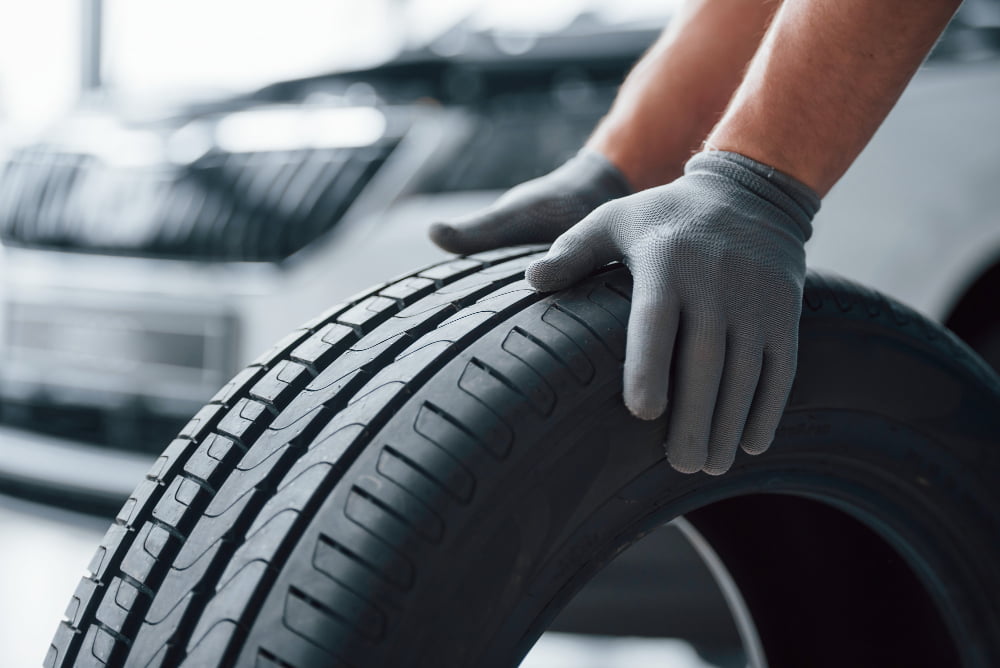
Once the tires are sparkly clean, it’s time to pack them for their period in the garage. Importantly, each tire should be stored in its own large, airtight plastic bag, such as a lawn and leaf bag. The fewer air inside the bag, the better; less air will limit the amount of natural rubber evaporation from the tires. A vacuum cleaner can be handy in extracting the air from the bag before sealing it. Reinforce the sealed area with tape to ensure that no air seeps in during storage.
If the tires you are storing have rims, it’s best to stack them vertically. However, rimless tires should be kept upright, in a tire stand or rack, as laying them flat could develop flat spots. Two considerations; spacing for easy accessibility and minimal pressure on the bottom tire if stacked. So, bagging followed by proper positioning ensures both longevity and readiness for use when needed.
Choose the Optimal Location in Your Garage for Tire Storage
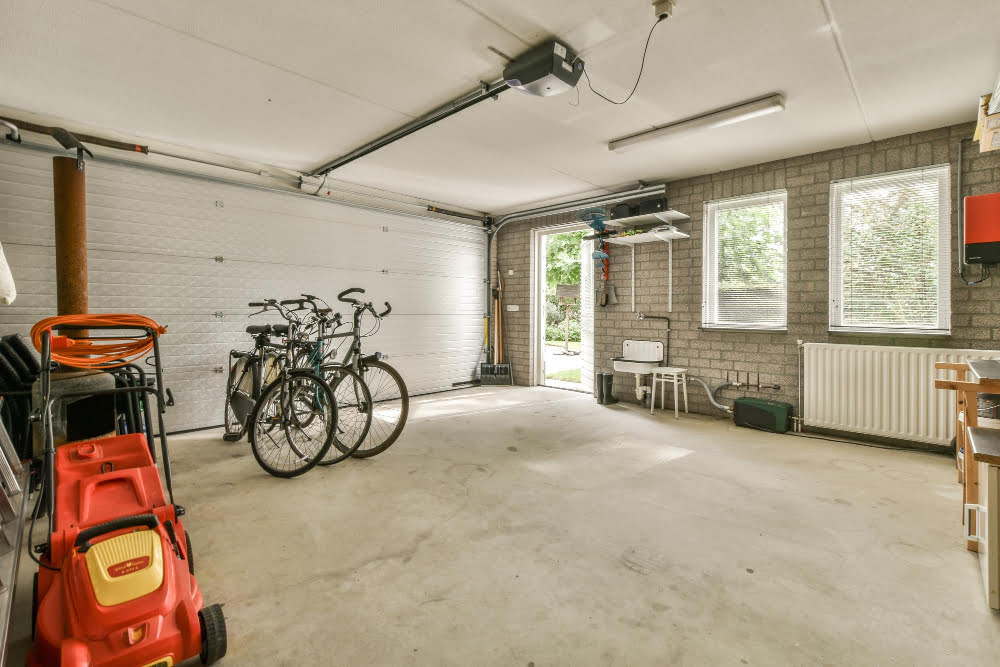
Selecting a suitable spot in your garage is paramount to the longevity of your tires. Position them away from direct sunlight, as UV rays can speed up the tire’s aging process, leading to cracks and other damages. Also, avoid areas with excessive heat, such as near a furnace or water heater.
Equally crucial is to keep the tires away from sources of ozone, such as electric motors or central vacuums, which can cause the rubber to deteriorate. Damp corners or spots prone to flooding should also be sidestepped to avoid water damage.
For minimal pressure on the tires, laying them flat is the best option, in a cool, dark, and dry section of your garage. If, however, space is a constraint, stand them upright but rotate their position every four weeks to redistribute the weight and prevent tire deformation.
Regardless of the storage method you choose, maintain a tidy environment around the tires to prevent dirt and debris from causing damage.
Lastly, remember to keep the tires from any sharp objects or tools that could cause potential punctures or tears. Some homeowners prefer to keep their stored tires in a dedicated tire rack or elevated platform for added safety and convenience.
Shield Stored Tires From Sunlight and Chemical Exposure
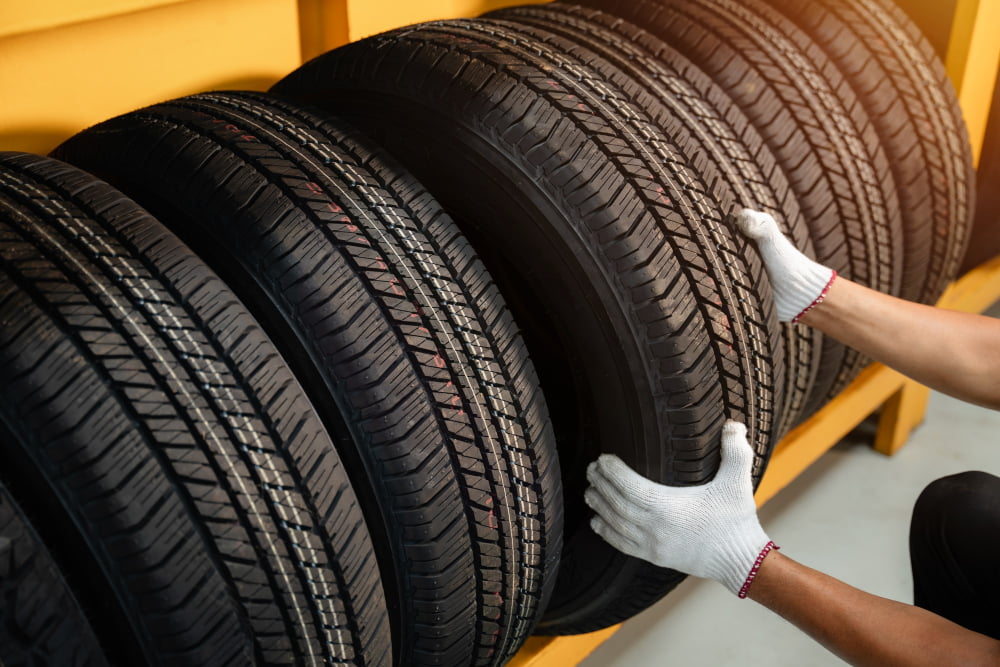
Direct sun exposure can speed up the process of your tires aging and deteriorating. Here’s your checklist:
- Make curtains or installing blinds a priority to obstruct sunlight from your garage windows.
- Be aware of the heat. Extreme temperatures can cause damage. Maintain a moderate, consistent temperature in your garage.
- Take note of the chemicals in your garage. Certain substances like petrol, oil, and grease can prematurely deteriorate the rubber when they come into contact with your tires. Make sure your tires are stored away from such chemicals.
- Protect tires using tire totes or specially designed tire storage bags for added protection against harmful elements.
Remember, investing time in these precautions can enhance the longevity of your tires, saving you from unnecessary replacement costs.
Specifics of Storing Tires With Rims in the Garage
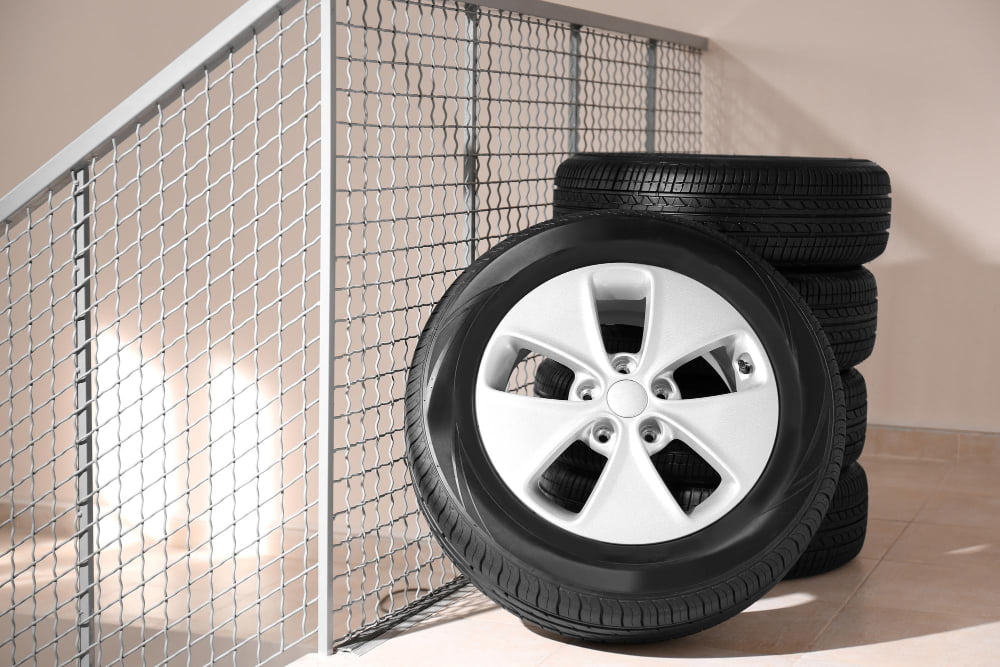
When dealing with tires mounted on rims, the ideal storage method differs slightly. For this scenario, you are suggested to store them in a stacked manner. This process involves laying the tires flat and stacking them on top of one another. It’s advised to not stack more than four tires high to ensure the stability.
You can rest easy knowing that the rims will help maintain the tire’s shape, reducing the risk of developing flat spots. A good practice here is to rotate the tire position in the stack periodically. This burden sharing ensures an even distribution of pressure and maintains the integrity of the tires over time.
Even though the rims offer a certain level of protection, it’s still crucial to keep them in a dry, moderately temperate area where there is no risk from chemical or climactic exposure. Remember, the enemy of tires is anything that can dry them out or compromise their rubber composition.
Keep in mind, tires are not everlasting. Aim to check your stored tires every couple of months. This check-up should include confirming the tires’ condition and ensuring they remain correctly inflated. Always follow the manufacturer’s guidelines for storage lifespan to ensure optimal performance when they are reused.
Protocol for Storing Tires Without Rims in the Garage
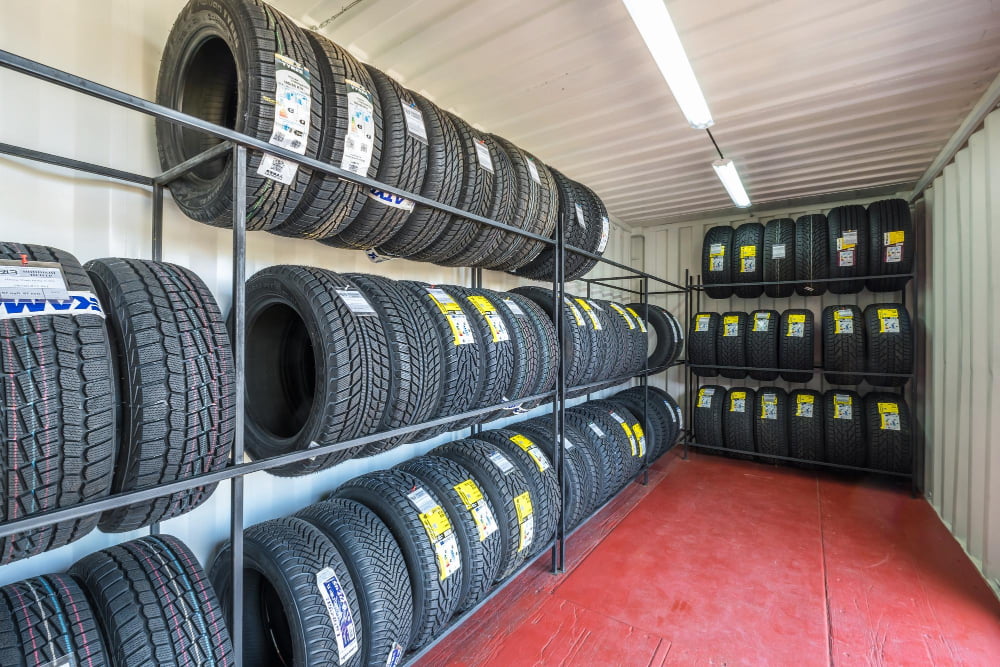
When storing tires without rims, there are a few essential things to be cautious about. First and foremost, ensure that these tires are appropriately cleaned and dried to prevent the buildup of mold or mildew. These tires should then be stored in an airtight plastic bag to prevent damage from fluctuating temperature or humidity changes.
The additional security of a fully filled tire bag ensures that the tire effectively withstands the weight of other tires when stacked. If vertically stacking these de-rimmed tires, make sure to rotate their positions every four weeks, significantly minimizing the risk of developing flat spots.
However, proper positioning becomes key to maximizing your storage space. The T-shape or vertical arrangement is ideal for tires without rims, as it saves on space and does not stress the tires. Always remember to never hang your tires from the ceiling or expose them to sunlight or harsh chemicals, as it could lead to premature aging or cracking. Follow these steps and your tires will be ready to roll when you need them again.
Techniques for Protecting White Rubber During Tire Storage
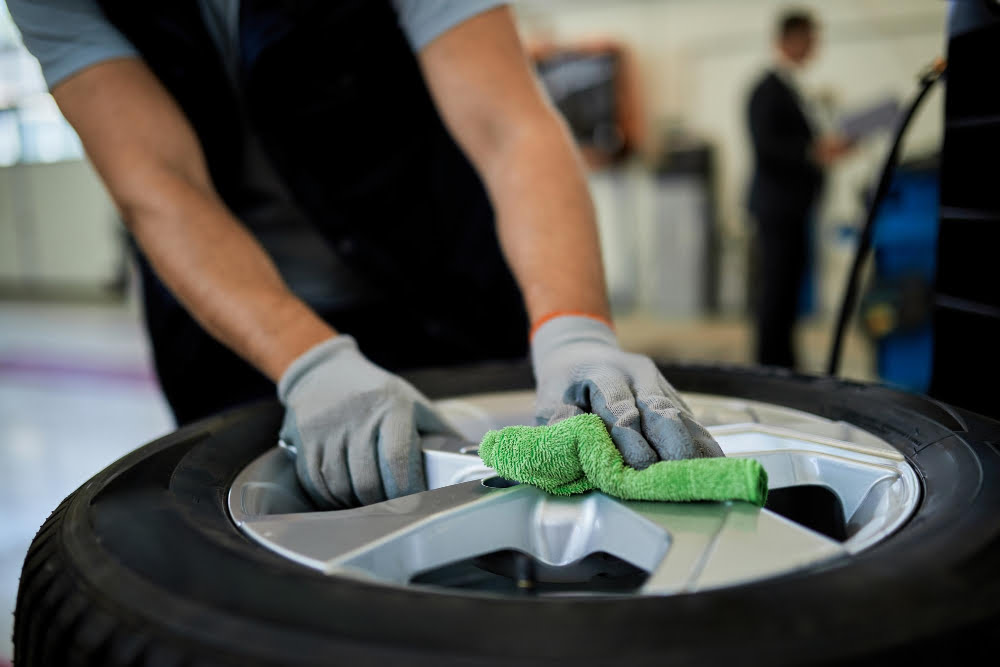
To maintain the original luster and prevent yellowing of the white rubber sections on your tires during storage, certain special measures need to be taken.
1. Wheel Covers: Using wheel covers is recommended. These can provide an extra barrier against dirt, dust, and other harmful elements that may stain or discolor the rubber.
2. Quality Cleaning Agents: Investing in an effective, non-abrasive cleaner meant specifically for white rubber will help get rid of any embedded dirt and keep the tires looking as good as new.
3. Tire Wax: Specialized wax for tires adds another layer of protection and helps maintain the white rubber’s shine.
4. Regular Inspection: A routine inspection checks during storage to swiftly address any emerging discoloration or other changes is beneficial.
Remember, a small amount of care goes a long way in preserving the appearance of your tires.
FAQ
Is it OK to store tires in the garage?
Storing tires in the garage is not recommended due to varying temperature ranges, humidity levels, and proximity to ozone sources such as electric motors and sump pumps.
How do I store extra tires in my garage?
To store extra tires in your garage, encase each in an airtight, moisture-free plastic bag, vacuum out the air, and tape the bag shut to prevent the evaporation of oils from the rubber compounds.
Is it better to store tires inflated or deflated?
For long-term storage, it’s generally preferable to store tires while they’re still inflated, after ensuring they are thoroughly cleaned and dried.
How long can you store tires in a garage?
Tires can typically be stored in a garage for around six to ten years, according to carmakers and tire manufacturers, before their usage should be reconsidered.
What are the best conditions for storing tires in a garage?
The best conditions for storing tires in a garage involve maintaining a consistent, cool temperature, avoiding direct sunlight, and keeping them off the ground on a clean, dry surface.
How does temperature affect tire storage in a garage?
Extreme temperatures in a garage, particularly cold, can contribute to the degradation of tires, causing them to lose their flexibility and grip.
Can storing tires in a garage impact their lifespan and performance?
Yes, storing tires in a garage can impact their lifespan and performance due to exposure to extreme temperature changes, humidity, or direct sunlight.